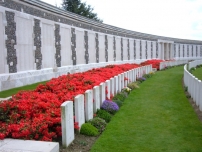| First Name: | Walter | Last Name: | BAILEY | |
|---|---|---|---|---|
| Date of Death: | 16/08/1917 | Lived/Born In: | Southgate | |
| Rank: | Sergeant | Unit: | Oxcford & Buckingham Light Infantry6 | |
| Memorial Site: | Tyne Cot Memorial, Belgium | |||
Current Information:
Third Battle of Ypres This was a campaign fought between July and November 1917 and is often referred to as the Battle of Passchendaele, a village to the north-east of Ypres which was finally captured in November. It was an attempt by the British to break out of the Ypres salient and capture the higher ground to the south and the east from which the enemy had been able to dominate the salient. It began well but two important factors weighed against them. First was the weather. The summer of 1917 turned out to be one of the the wettest on record and soon the battlefield was reduced to a morass of mud which made progress very difficult, if not impossible in places. The second was the defensive arrangements of concrete blockhouses and machine gun posts providing inter-locking fire that the Germans had constructed and which were extremely difficult and costly to counter. For 4 months this epic struggle continued by the end of which the salient had been greatly expanded in size but the vital break out had not been achieved. The Battle of Langemarck This took place between 16th-18th August, 1917 and was the second general attack of 3rd Ypres. Although it did not rain during the two days of the battle itself there had been plenty of it in the preceding days and in many places the battlefield was a quagmire. On the left of the attack in the north-west of the Ypres salient there was considerable success, especially for the French Army which attacked on the left of the British, but the attack on the Gheluvelt Plateau, due east of Ypres, met determined German resistance and the early gains were soon reversed. At 4.45am on 16th August, 20th Division attacked in the northern part of the battle front towards the village of Langemarck itself. They used 60 and 61 Brigades for this successful operation and by 7.45am the final objectives had been captured. 60 Brigade attacked on the right with 6th Oxford & Bucks Light Infantry in front and 6th Shropshire Light Infantry and 12th King’s Royal Rifle Corps, following behind. 12th Rifle Brigade were in reserve with one of their companies attached to 6th Oxford & Bucks as ‘moppers-up’, following close on their heels, dealing with any of the enemy left behind. Despite movement being restricted to small columns of men winding their way through water filled craters, 6th Oxford & Bucks made good progress. The two companies on the left faced the most opposition from the enemy blockhouse at Au Bon Gite and from other strongholds further forward but they reached their objectives on time after which the second wave passed through to continue the attack. By the time the battalion was relieved on the night of 18th August, they had suffered over 200 casualties one of whom was Walter Bailey who was killed on 16th August. |
||||
| « Back to Search Results | ||||
| If you think any of the information shown here is incorrect, Click Here to submit your amends and comments | ||||




